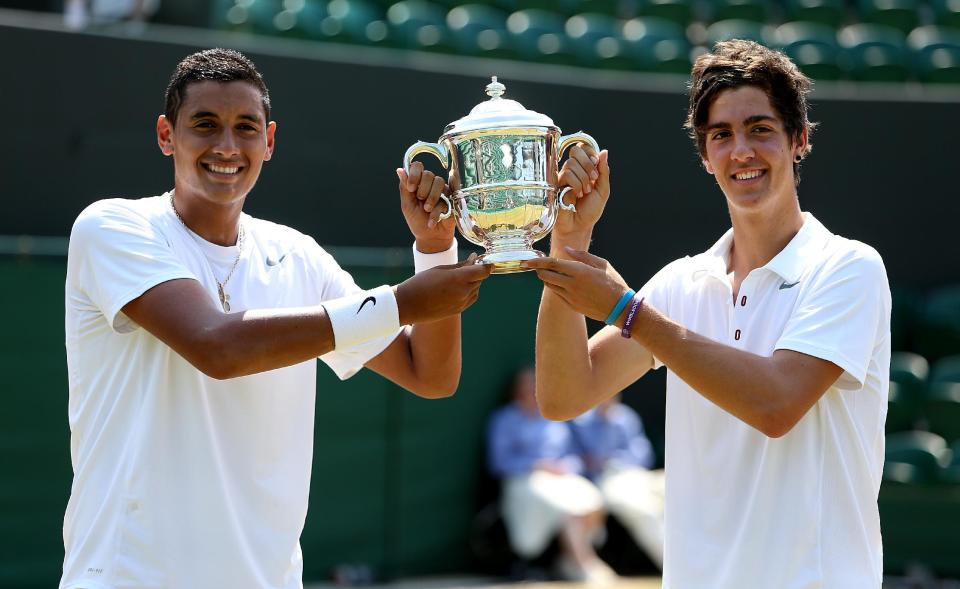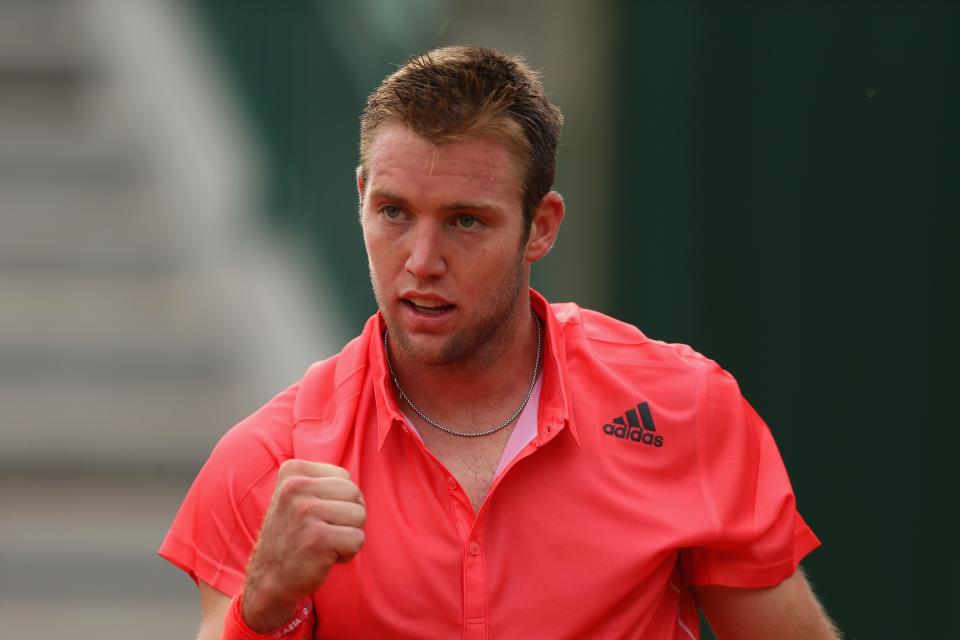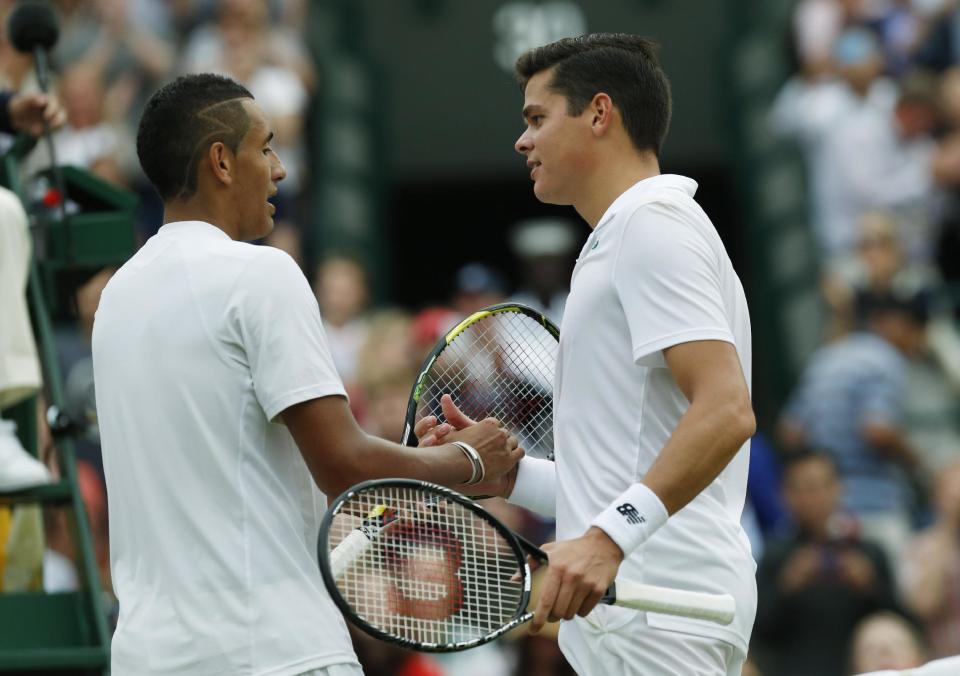The New next generation in men's tennis, led by Aussies Kokkinakis and Kyrgios, still not quite ready

PARIS – It seems like only yesterday that Canadian Milos Raonic was among the new generation of players who would push the icons at the top of the men's game, and eventually conquer them. Grigor Dimitrov was part of that group, as were Japan's Kei Nishikori and Aussie Bernard Tomic.
It hasn't happened – yet – although both Raonic and Nishikori have become mainstays in the top 10. Other than a U.S. Open finals appearance by Nishikori last summer, they haven't done anything to permanently unsettle the Mount Rushmore of tennis: Djokovic, Federer, Nadal and Murray.
That didn’t stop the constant questions about when the “next generation” was going to have a breakthrough. Every victory over a top player, every start of a run in a major, brought the same questions. But over the last year, a new crop of talented youngsters has emerged. And most of them are having a lot more success while still in their teens than those who came before them.

Aussies Nick Kyrgios (just turned 20) and Thanasi Kokkinakis (just turned 19) and Croatia's Borna Coric (18) have talent to burn, and their on-court and off-court charisma leaps out at tennis fans in a way the previous group, who for the most part let their racquets do the talking, can only dream of.
(Oh yes; it's worth noting that Nike has all three of them in its stable, as the company works to lay the groundwork for a world in which current spokesman Federer and Nadal no longer rule)
Saturday at Roland Garros, all three had big opportunities on one of tennis's biggest stages to make a statement. The results of the day proved, once again, that not only are the players at the top of the men's game at the moment surreally good, they're also not ready to be cast aside any time soon.
And it’s entirely likely that on these occasions, when they face the upstarts who come in with so much insouciance and so much hype, they find special motivation.
First up Saturday was Andy Murray against Nick Kyrgios, the outsized, brash Aussie who defeated Rafael Nadal at Wimbledon last year. Murray won, 6-4, 6-2, 6-3, although Kyrgios came to court with an elbow issue and was unable to serve the way he wanted to.
Next up was Kokkinakis, who faced Novak Djokovic on Court Suzanne Lenglen. The veteran prevailed 6-4, 6-4, 6-4 in a competitive contest, but one in which the world No. 1 was never in trouble.
Last came Coric, who had a relatively easier task against unseeded American Jack Sock.
Not so easy; Sock trounced him 6-2, 6-1, 6-4.
That victory, in addition to Sock’s routine first-round upset win over No. 10 seed Dimitrov, now puts him squarely in that next-next-generation conversation. At 22, he’s a little older, but a late bloomer in relative terms.
The totals for the three young guns: Three matches, nine sets played, none won.
“I felt like I served all right. I played all right. Just wasn't quite enough,” Kokkinakis said. “(Djokovic) just doesn't give you anything, any free points. He didn't serve a double fault. I saw the stats. Not one.”
Kyrgios basically said the same thing about Murray. “He's a freak athlete. You know, he's strong. I think that's how he has his advantage when he plays. He gets to so many balls, mixes up well, great feel and great slice,” he said.

Perhaps, in those words, you can gets a sense of why those at the top stay on top. Federer is obviously a different animal. And Nadal is unlike any other but as ferocious as his forehand is, the basics remain: he’s strong, he gets to every ball, and he doesn’t give you anything.
Of all the top players, it has been Murray who has gone out of his way to befriend both young Aussies. Know thine enemy, as the old expression goes.
“I think all of those guys are good for the game. I mean, some of them – Nick and Thanasi are, you know, they are pretty fun, outgoing, you know, personalities off the court and on it. Then there are some of the younger guys that aren't like that, like a Coric, for example, he's a little bit different to them,” Murray said. “I think that's good. I think when everyone is the same that's not as much fun for everyone. I enjoy watching Thanasi and Nick play. They are entertaining.”
Djokovic, too, has noticed these young guns; in fact, he has said on more than one occasion that Coric reminds him very much of himself (he even looks like him; he could easily be the fourth Djokovic brother).
“I think that tennis needs players like Thanasi, who is a teenager, but still able to come out on centre court and play with courage and play with power and believe in himself. He's one of this group of three, four young players that are, you know, starting to be more and more consistent and make couple of big wins in their careers,” Djokovic said.
“You know, for a few years people were saying, ‘Oh, now the game is so physical you can't break through until you're 20, 21 years old, but the reality was it was just a few-year period where there was a few juniors that weren't as good. And now you see you have some great young players coming through that are going to be top of the game for a long time,” Djokovic said. “They have done extremely well from a young age, and, yeah, I have followed them the last couple of years and watched a lot of their matches on the Tour.”
The two young Aussies are fuelling each other and not incidentally seem to have had an effect on Tomic, who is experiencing a revival of sorts this season and is still, it’s easy to forget, only 22.
“It was definitely tough last year watching Nick break through. I'm not going to lie. Because I was playing a challenger in Winnetka (Illinois) I think, and I lost first round and he just beat Nadal (at Wimbledon). I was like, ‘Wow, what am I doing?’ I had a look at it and I worked hard to put myself in these positions to play greatest players on big courts.”
Sock is the wild card in all this, as the tennis world seemed to give up on having a true blue-chip prospect from the U.S. some years ago. In his earlier years, he was clearly less fit, far less disciplined on the court and didn’t seem nearly as driven and intense as he needed to be.
Slowly, things are starting to fall into place although from what he says, his tournament diet remains resolutely American - Chipotle and room service, for the most part. His doubles success with Canadian Vasek Pospisil had no small part to play in his evolution; being in tournaments until the final weekend – especially at a Grand Slam, as they were when they shocked everyone as an unseeded team in their first tournament together and won the Wimbledon doubles – is motivating like nothing else.

As well, Sock has matured, even if he remains the most laid-back cat you’ll find on a tennis court, a master of providing pithy and hilariously personal play-by-play of his own matches as he’s playing them. A serious illness suffered by his beloved brother Eric was a bit of a reality check. As well, Sock’s season only began in Indian Wells after he had hip surgery late in 2014. He won his first career ATP title in Houston last month, in the only red-clay event held in the U.S. Sock has dedicated his efforts in this French Open to his grandfather, who is struggling with Alzheimer’s disease.
The American’s howitzer of a forehand is starting to be right up there with that of Rafael Nadal as one of the feared weapons in the game. And in watching him play a lot because of the association with Pospisil in doubles, it’s clear that he’s actually a far more well-rounded player than most had given him credit for.
On the velocity side, that forehand ranks just below that of Nadal. And what sets it apart from all the other big forehands in the game is the vicious spin Sock gets on it – not quite like Nadal’s forehand, but in the same area code. In all of Nadal’s career, it might be the first time anyone else’s forehand has even come close.
After they lost to Pospisil and Sock at Wimbledon, the Bryan brothers said the forehand was almost like an overhead; that’s how hard he hits it. Not only that, Sock LIKES clay.
Let the record show that Raonic played Sock five times in 2014 – and won all five. He played Kyrgios twice last year – both at the French Open and Wimbledon – and dropped just one set in winning both. He has yet to play either Kokkinakis or Coric.

All of which to say, don’t count out the “old” new guard just yet. We’ll see what Raonic, who is just 24, has to say about the new crew once he returns to action on the grass.

 Yahoo Sports
Yahoo Sports 

